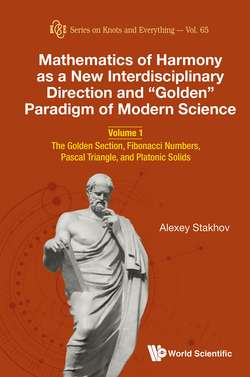Читать книгу Mathematics of Harmony as a New Interdisciplinary Direction and “Golden” Paradigm of Modern Science - Alexey Stakhov - Страница 10
На сайте Литреса книга снята с продажи.
The Statements by Alexey Losev and Johannes Kepler
ОглавлениеWhat was the main idea behind ancient Greek science? Most researchers give the following answer to this question: The idea of Harmony connected to the golden section. As it is known, in ancient Greek philosophy, Harmony was in opposition to the Chaos and meant the organization of the Universe, the Cosmos. The outstanding Russian philosopher Alexey Losev (1893–1988), the researcher in the aesthetics of the antiquity and the Renaissance, assesses the main achievements of the ancient Greeks in this field as follows [5]:
“From Plato’s point of view, and in general in the terms of the entire ancient cosmology, the Universe was determined as the certain proportional whole, which obeys to the law of the harmonic division, the golden section . . . The ancient Greek system of the cosmic proportion in the literature is often interpreted as the curious result of the unrestrained and wild imagination. In such explanation we see the scientific helplessness of those, who claim this. However, we can understand this historical and aesthetic phenomenon only in the connection with the holistic understanding of history, that is, by using the dialectical view on the culture and by searching for the answer in the peculiarities of the ancient social life.”
Here, Losev formulates the “golden” paradigm of ancient cosmology. This paradigm was based upon the fundamental ideas of ancient science that are sometimes treated in modern science as the “curious result of the unrestrained and wild imagination”. First of all, we are talking about the Pythagorean Doctrine of the Numerical Universal Harmony and Plato’s Cosmology based on the Platonic solids. By referring to the geometrical structure of the Cosmos and its mathematical relations, which express the Cosmic Harmony, the Pythagoreans had anticipated the modern mathematical basis of the natural sciences, which began to develop rapidly in the 20th century. Pythagoras’s and Plato’s ideas about the Cosmic Harmony proved to be immortal.
Thus, the idea of Harmony, which underlies the ancient Greek doctrine of Nature, was the main “paradigm” of the Greek science, starting from Pythagoras and ending with Euclid. This paradigm relates directly to the golden section and the Platonic solids, which are the most important Greek geometric discoveries for the expression of the Universal Harmony.
Johannes Kepler (1571–1630), the prominent astronomer and the author of “Kepler’s laws”, expressed his admiration with the golden ratio in the following words [6]:
“Geometry has the two great treasures: the first of them is the theorem of Pythagoras; the second one is the division of the line in the extreme and mean ratio. The first one we may compare to the measure of the gold; the second one we may name the precious stone.”
We should recall again that the ancient task of dividing line segment in extreme and mean ratio is Euclidean language for the golden section!
The enormous interest in this problem in modern science is confirmed by the rather impressive and far from the complete list of books and articles on this subject, published in the second half of the 20th century and the beginning of the 21st century [1–100].
